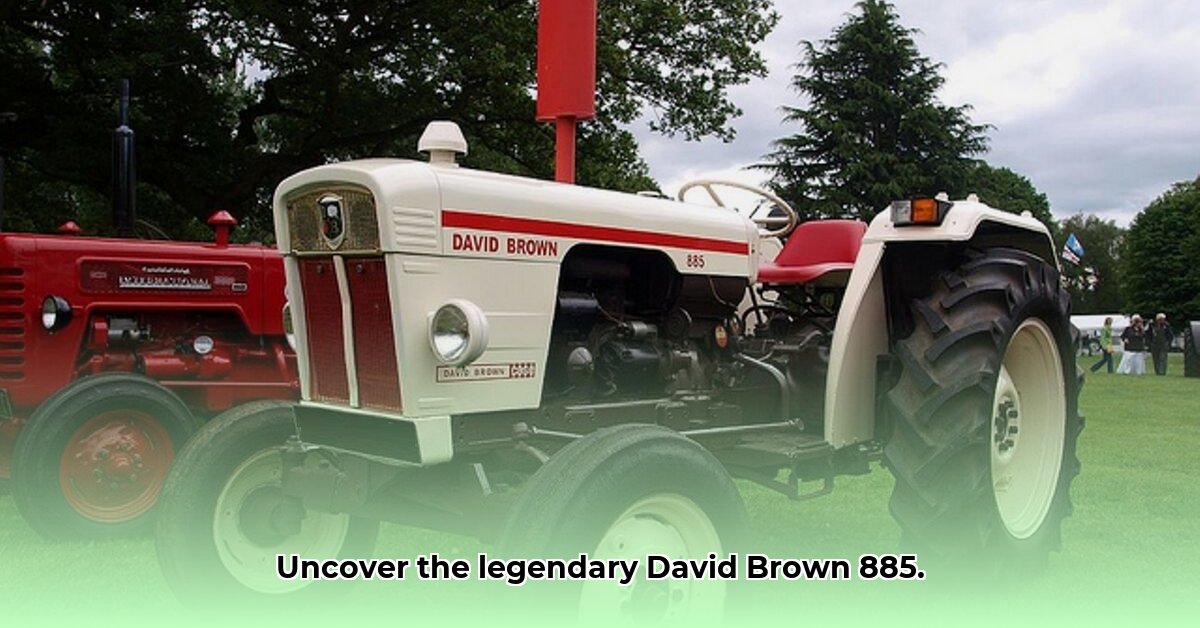
The David Brown 885 tractor: a name synonymous with robust British engineering and unwavering dependability. This iconic machine, produced primarily during the late 1960s and early 1970s, remains a cherished piece of agricultural history and a testament to a bygone era of quality craftsmanship. This comprehensive guide delves into the heart of the 885, examining its history, key features, maintenance, and lasting legacy, providing valuable insights for both seasoned enthusiasts and curious newcomers. For even more in-depth information, check out this dedicated website: 885 Tractor Info.
A Glance into History: The Genesis of the 885
The David Brown 885 emerged during a pivotal period in agricultural technology. Farmers sought machinery that could match the escalating demands of increasingly efficient farming practices. David Brown, renowned for its innovative designs and sturdy builds, responded with a tractor meticulously designed to meet these evolving needs.
While not a radical departure from its predecessors, the 885 represented a significant refinement. It embodied a move towards larger, more versatile tractors capable of handling a broad spectrum of agricultural tasks. Its reputation for unwavering reliability cemented its place in the agricultural landscape, becoming a mainstay on farms across the UK and beyond. This steadfast dependability ensured the 885's continued presence even as newer models entered the market.
Under the Hood: Power and Precision
The David Brown 885 typically boasted a powerful four-cylinder diesel engine, providing robust power for plowing, harvesting, and various demanding agricultural operations. The exact specifications could vary slightly depending on the year of manufacture. However, the consistent feedback from owners highlights the engine's exceptional power-to-weight ratio.
The transmission system was equally renowned for its robustness and surprisingly smooth operation. Coupled with a well-engineered hydraulic system, it enabled precise control of implements, simplifying tasks such as hay baling or operating a front-end loader. This ease of operation enhanced productivity and significantly reduced operator fatigue. Isn't precise control a crucial factor when considering vintage tractors for demanding agricultural tasks?
Furthermore, for its time, the 885 offered a surprisingly comfortable operator experience. While not matching the amenities of modern tractors, the available cab (a feature not present on all models) provided substantial protection from the elements and improved visibility. Many owners cite the relative ease of maintenance as a major advantage over competing models of the era.
Beyond the Farm: Versatility and Adaptability
The versatility of the David Brown 885 extended far beyond the confines of the farm. Its robust build and adaptability made it a suitable choice for various applications. Construction sites, forestry operations, and even light hauling were common uses, underscoring the machine's adaptability and overall strength. This versatility likely contributed significantly to its widespread popularity and longevity.
A Balanced Perspective: Weighing the Pros and Cons
The David Brown 885, like any other machine, presents both advantages and disadvantages. Considering its age, it's crucial to weigh these aspects carefully.
Pros:
- Powerful and reliable engine: Delivering consistent performance in various conditions.
- Smooth transmission: Ensuring effortless operation and precise control.
- Relatively easy maintenance: Minimizing downtime and maintenance costs.
- Versatile and adaptable for various tasks: Extending its usability beyond farming.
Cons:
- Older technology; parts can be harder to find: Requiring specialized sourcing or patience.
- Cab comfort might be less than modern tractors: A common characteristic of vintage machinery.
- Some models may require specialized tools: Adding to the overall maintenance requirements.
- Fuel efficiency might be lower than newer models: A factor to consider in terms of operating costs.
Maintaining Your 885: A Guide to Longevity
Proper maintenance is crucial for preserving the longevity and robust performance of a David Brown 885. This involves regular oil changes, filter replacements, and meticulous inspection of the hydraulic system. Consulting a repair manual specific to your model year is highly recommended. Finding parts might require more effort, with online forums and vintage tractor communities serving as invaluable resources for sourcing parts and seeking expert advice. Did you know that a well-maintained 885 can provide decades of reliable service?
The Enduring Legacy: A Timeless Classic
The David Brown 885 transcends its status as a simple vintage tractor. It stands as a significant piece of agricultural history, representing an era of robust construction and straightforward functionality. While modern tractors boast advanced technology, the 885's continued popularity speaks volumes about its dependability and enduring design. The many enthusiasts who diligently restore and maintain these machines highlight its enduring appeal.
Key Takeaways:
- The David Brown 885 was a robust and reliable tractor built for demanding agricultural tasks.
- Its versatility extended beyond farming, finding applications in construction and other industries.
- Proper maintenance is crucial to ensuring the longevity and optimal performance of the machine.
This article provides a comprehensive overview of the David Brown 885, drawing upon publicly available information and common knowledge regarding this vintage tractor. There are no specific or confidential materials used.